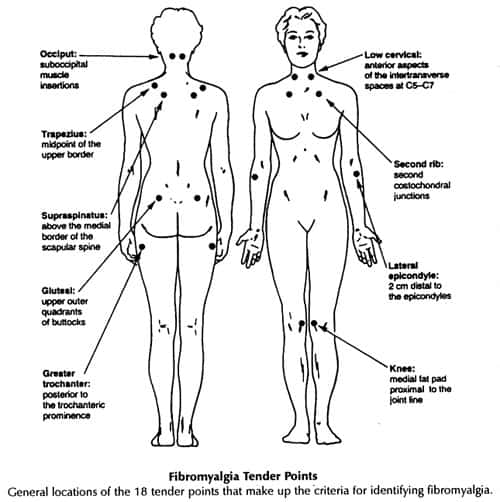Diagnosis:
American college of rheumatology criteria –
Widespread pain for more than 3 months (pain left and right body, above and below waist, axial skeleton pain)
Trigger point tenderness (more than 11 out of 18 trigger points):
- trigger points – occiput (bilateral, suboccipital), low cervical (bilateral C5-7), trapezius (bilateral, midline upper), supraspinatus (bilateral, above scapula spine medial border), second rib (bilateral, 2nd chostochondral junctions), lateral epicondyle (bilateral), gluteal (bilateral, upper outer quadrant), greater trochanter (bilateral, posterior to trochanteric process), knee (bilateral, medial fat pad proximal to joint line).

Fatigue – very common and disabling. May have some emotional/ psychological trauma.
Vegetative/ functional disorders – non restorative sleep, depression/ anxiety.
Differential Diagnosis:
SLE (systemic lupus erythematosus), polymyositis/ dermatomyositis, PMR (polymyalgia rheumatica) [elderly – mainly stiffness], Carcinoma.
Investigations needed:
FBC, ESR, ANA (DsDNA, ENA- anti centromere/ antiscl70), Immunoglobulins, Rheumatoid factor, CK, thyroid function tests.
Management:
- Multidisciplinary/ inter-professional – Central sensitisation, cognitive beliefs.
- Predictors of chronicity – previous pain, trigger points positive, distress, somatisation, fatigue, non restorative sleep, increased age, family history of chronic pain, low socioeconomic status. Also obesity, smoking, hypermobility and sedendary lifestyle.
- Pharmacological –
- Analgesia – nocioceptive pain – often normal analgesia does not help.
- Tricyclics (amitriptyline) or SSRI’s or gabapentin/ pregabalin.
- Non pharmacological –
- Physical exercise – graduated exercise programme reduces pain/ increases function, improves sleep pattern, reduces fatigue/ low mood.
- CBT (cognitive behavioural therapy) – active self management helps.
- Acupuncture – not enough evidence.
- Good predictors of prognosis – very distressed patients with significant deleterious effects on activities of daily living ( especially with CBT therapy). Short history of disease. Treatment started ASAP.


